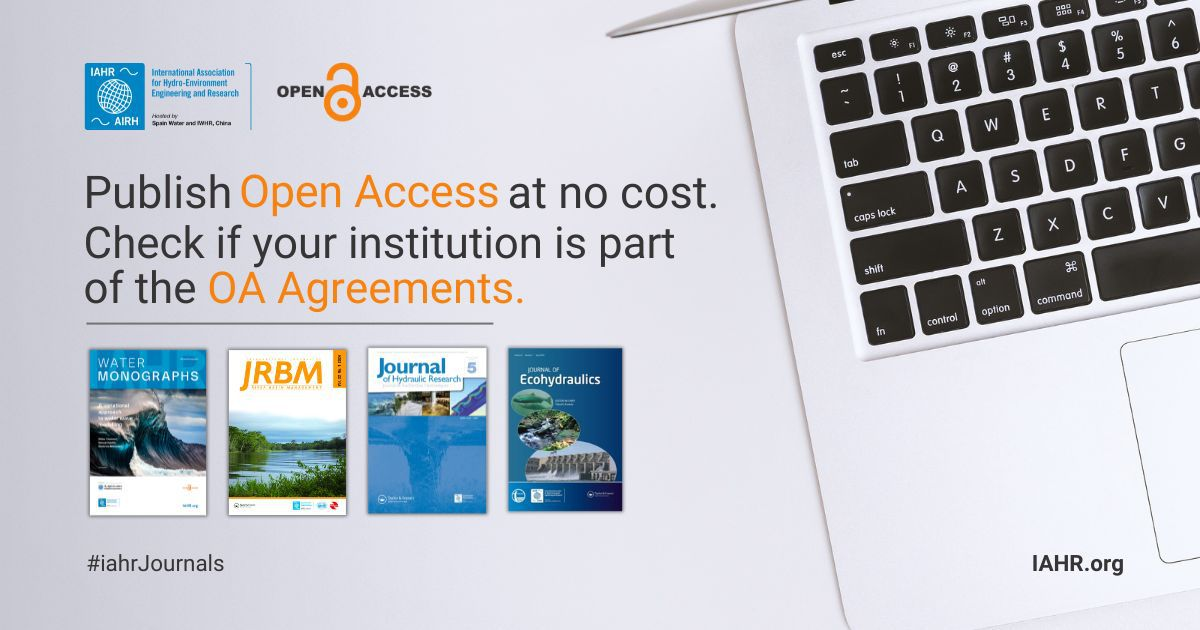The Journal of Ecohydraulics 3, 2025 is now published!
 The Journal of Ecohydraulics (JoE) is an international, peer reviewed journal, publishing high-quality, original research. It publishes varied research undertaken in ecohydraulics, covering water resources and aquatic life, ecology, biology, hydraulics, engineering, geoscience, environmental science, climate change, and other related fields, with an emphasis on the integration of these disciplines and the contributions they can make for a sustainable future.
The Journal of Ecohydraulics (JoE) is an international, peer reviewed journal, publishing high-quality, original research. It publishes varied research undertaken in ecohydraulics, covering water resources and aquatic life, ecology, biology, hydraulics, engineering, geoscience, environmental science, climate change, and other related fields, with an emphasis on the integration of these disciplines and the contributions they can make for a sustainable future.
IAHR members can access the latest issue online.
Non IAHR members must access through Taylor & Francis website.
Overview
Recent research continues to advance ecohydraulics as an integrative science connecting hydrodynamics, morphology, and aquatic ecology across multiple scales. The Journal of Ecohydraulics Vol. 10(3) features six research articles and two commentaries exploring these interdisciplinary links.
Laboratory studies on chub, barbel, and brown trout exposed to pulsed direct current fields identified optimal pulse parameters for fish guidance at hydropower intakes. CFD analysis of gudgeon revealed how body shape and boundary-layer flow influence sensory perception via the lateral line.
At the habitat scale, engineered scour structures were found to create drought-resilient deep-pool refuges. Research on hydropeaking showed that discharge fluctuation frequency significantly contributes to ecological stress. Flow modeling through vegetative patches demonstrated how patch geometry affects vortex formation and flow resistance, highlighting vegetation–flow interactions.
Larger-scale investigations linked fish community structure in the upper Awash River to hydraulic diversity, while hydrological modeling in Nigeria indicated groundwater decline and weakened environmental flows. Coastal monitoring also showed that dredging alters turbulence and oxygen distribution, informing adaptive management strategies.
Collectively, these studies position ecohydraulics as a framework for understanding physical–biological feedbacks, enabling more resilient design and restoration of aquatic systems amid environmental change.
Research Articles
Behavioural response of chub, barbel and brown trout to pulsed direct current electric fields | ![]()
Anita Moldenhauer-Roth, Oliver M. Selz, Ismail Albayrak and Robert M. Boes
Pages: 249-264 | DOI: 10.1080/24705357.2024.2426806
3D CFD analysis of pressure, boundary layer and shear stresses on a gudgeon (Gobio gobio) | ![]()
Ali Hassan Khan, Stefan Hoerner, Gert Toming, Maarja Kruusmaa and Jeffrey A. Tuhtan
Pages: 265-279 | DOI: 10.1080/24705357.2024.2426809
Morphodynamics of ecological scours as deep pool habitats | ![]()
Christin Kannen, Frank Seidel and Mário J. Franca
Pages: 280-301 | DOI: 10.1080/24705357.2024.2426808
Comment
Why hydropeaking frequency matters: effects of recurring stranding on fish | ![]()
Daniel S. Hayes, Nico Bätz, Diego Tonolla, Kevin Merl, Stefan Auer, Lorenzo Gorla, Christine Weber, Robert Naudascher, Luiz G. M. Silva, Stefan Schmutz, Günther Unfer, Simon Führer, Bernhard Zeiringer and Franz Greimel
Pages: 302-318 | DOI: 10.1080/24705357.2024.2426820
Research Articles
Investigation of flow behavior within staggered vegetation patches of various shapes in an open channel
Naveed Anjum, Sohail Iqbal, Mustajab Ali, Ghufran Ahmed Pasha and Abdul Razzaq Ghumman
Pages: 319-337 | DOI: 10.1080/24705357.2025.2450823
Comment
Analytical modeling of hydrological processes for effective water governance input: the Nigerian River Basins perspective
Stephen Nwoba Ukpai
Pages: 338-355 | DOI: 10.1080/24705357.2024.2426821
Research Articles
Community structure and habitat preferences of stream fish in major tributaries of the upper Awash River, Ethiopia
Habtamu Tadesse, Aschalew Lakew and Abebe Getahun
Pages: 356-365 | DOI: 10.1080/24705357.2025.2462295
A framework for data analysis from long-term monitoring in anthropized coastal areas
Francesca De Serio, Diana De Padova, Mouldi Ben Meftah and Michele Mossa
Pages: 366-388 | DOI: 10.1080/24705357.2024.2428959

